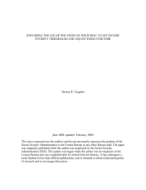
An official website of the United States government
Here’s how you know
Official websites use .gov
A .gov website belongs to an official government organization in the United States.
Secure .gov websites use HTTPS
A lock (
) or https:// means you’ve safely connected to the .gov website. Share sensitive information only on official, secure websites.
-
//
- Census.gov /
- Library /
- Census Working Papers /
- Use of the Views of the Public to Set Income Poverty Thresholds
Exploring the Use of the Views of the Public to Set Income Poverty Thresholds and Adjust Them Over Time
Exploring the Use of the Views of the Public to Set Income Poverty Thresholds and Adjust Them Over Time
Abstract
This article will discuss the role that the systematically measured judgments of the public at large might play in the measurement of poverty. Special attention will be given to how such assessments might be used to set the minimum income associated with a poverty welfare level and to track such a level over moderately long periods of time. The central importance of understanding how of the public's views of poverty thresholds vary with respect to secular trends in real family income will be stressed. It will be argued that this can best be done by thinking through the issue in the broadest possible social science framework. Indeed, before the reasonableness of any updated poverty threshold can be assessed, it is important to think more carefully about the sort of social processes that translate increases in real income into increases in the value of a minimally adequate income in the eyes of the members of society and how these processes work. By way of an empirical illustration, particular attention will be given to how one threshold series, based on the so-called Gallup get-along question, has varied over the post-World War II period with respect to median family income on both a before- and after-tax basis. The same series will be used to move a recent one-time assessment of the poverty threshold by a representative sample of the public back to the late 1940's.
Others in Series
Working Paper
Working Paper
Working Paper
Share
Related Information
WORKING PAPER
Supplemental Poverty Measure Working PapersSome content on this site is available in several different electronic formats. Some of the files may require a plug-in or additional software to view.
 Yes
Yes
 No
NoComments or suggestions?


Top

